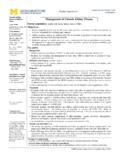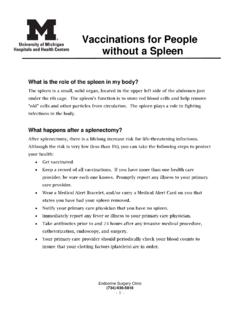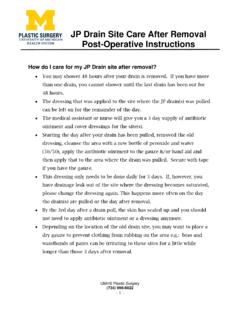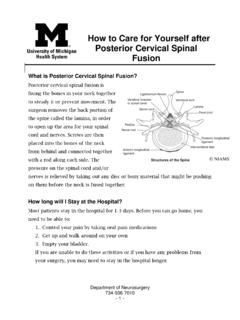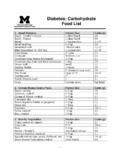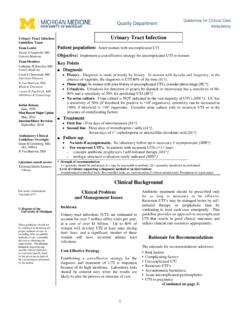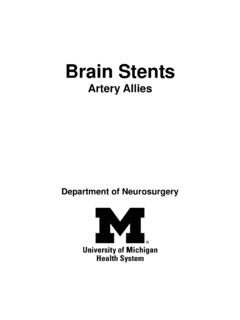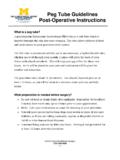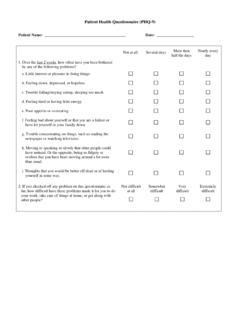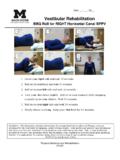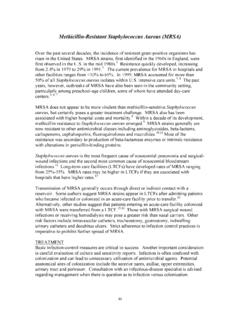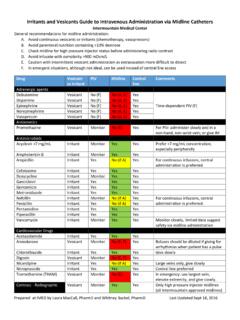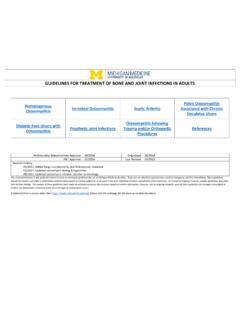Transcription of n GUIDELINES FOR TREATMENT OF CLOSTRIDIUM …
1 GUIDELINES FOR TREATMENT OF CLOSTRIDIUM DIFFICILE COLITIS IN ADULTS Prior studies show that 3-26% of hospitalized patients are asymptomatically colonized with C. difficile. Available assays are not able to distinguish between C. difficile infection and colonization, and TREATMENT of asymptomatic colonization is not recommended. Patients with new-onset diarrhea without an alternative explanation should be considered for CDI testing. Diarrhea is defined as 3 unformed stools in 24 hours. A large percentage of hospitalized patients have other reasons for diarrhea, such as laxatives, chemotherapy, and enteral tube feeds. When possible, one should consider first stopping therapies to which diarrhea may otherwise be attributed ( , laxatives), and then reassess prior to testing for CDI.
2 New-onset stools within 24 hrsAlternative explanation of diarrheaNo alternative explanation of diarrheaConsider test for CDIL axative us eTu be feeds initiation in past 48 hrsOral contrast receipt within pas t 48 hoursOther explanation: testing should be guided by pt s risk factors for CDI & clinical statusDiscontinue laxative, reassess in 48 hrsResolution of diarrhea: do NOT test for CDIP ersis tent diarrhea: consider tes t for CDIR eass es s 48 hrs after contras t administrationReass es s 48 hrs after tube feed initiation 1. The CLOSTRIDIUM difficile by PCR assay is the preferred test for CDI. The Gastrointestinal Pathogen Panel is a multiplex PCR assay that, in addition to CDI, tests for 21 other primarily community-acquired gastrointestinal pathogens and costs ~3x more than the dedicated C.
3 Difficile by PCR assay. The GI Panel is intended for use in patients with diarrhea that began prior to or within three days of hospitalization and there is concern for other etiologies aside from C. difficile. Both tests provide the same diagnostic information regarding C. difficile: a PCR and a toxin result. There is no role for performing both tests simultaneously or performing a C. diff PCR after a positive GI Panel result. These practices do not change management, lead to overutilization of testing resources, and should be avoided. Either assay may remain positive for up to 30 days after successful TREATMENT ; tests of cure should not be performed. As such, orders for repeat testing within 14 days of positive will be rejected by Microbiology Lab.
4 In addition, repeat testing within 7 days of a negative test will also be rejected by Microbiology Lab due to low likelihood of acute infection within this time frame. The ordering provider will be notified by pager, and in situations with a significant change in clinical status accompanied with high clinical suspicion, may contact the lab to request that testing proceed. 2. In the presence of an ileus, rectal swabs or solid stool in a cup are acceptable specimen types. Rectal swabs must be submitted dry (without transport fluid), as the dilutionary effect of the liquid Amies transport may impact the sensitivity of the C. difficile PCR and toxin EIA. Page 2 of 3 PCR Result EIA Toxin Result Interpretation Negative -- No C. difficile present. The negative predictive value of this test for ruling-out C.
5 Difficile-associated diarrhea approaches 99% Positive Positive Toxigenic C. difficile present. Positive Negative The gene that produces C. difficile toxin is detected, but toxin is not detected. This may represent either colonization or active clinical infection. Clinically correlate to determine if TREATMENT is warra nted. TREATMENT of CLOSTRIDIUM difficile colitis For all patients: - Discontinue/change antibiotics if possible. - Avoid PPI/H2 blockers without an appropriate indication. - Implement infection control measures Clinical Setting Initial Episode1,2 First Recurrence1,2,4 90 days from prior episode Second Recurrence1,4,6 90 days from prior episode Non-Fulminant Disease Consider Infectious Diseases and Surgery consultation in patients with severe disease (defined as WBC 15,000, absolute neutrophil count 500, or SCr times premorbid level) Preferred TREATMENT : vancomycin 125 mg PO QID x 10 days Solid organ transplant patients:5 Fidaxomicin 200 mg PO BID x10 days7,8 OR vancomycin 125 mg PO QID x10 days True vancomycin allergy (not vancomycin infusion reaction).
6 Fidaxomicin 200 mg PO BID x10 days Metronidazole 500 mg PO TID x10-14 days can be considered in non-severe CDI if above agents are unavailable to patient due to cost Infectious Diseases consultation is recommended If vancomycin was used for the initial episode: Fidaxomicin 200 mg PO BID x10 days7,8 OR Fidaxomicin 200 mg PO BID x5 days then 200 mg PO every other day x20 days7,8 OR vancomycin 125 mg PO QID x14 days then taper6 over 5-11 weeks If fidaxomicin was used for the initial episode: Fidaxomicin 200 mg PO BID x10 days7,8 OR Fidaxomicin 200 mg PO BID x5 days then 200 mg PO every other day x20 days7,8 Infectious Diseases consultation is strongly recommended The following options may be considered in consultation with Infectious Diseases6: - Repeat vancomycin taper - Fidaxomicin 200 mg PO BID x10 days - Fidaxomicin 200 mg PO BID x5 days then 200 mg PO every other day x20 days - Fecal microbiota transplant - Kefir staggered protocol - Bezlotoxumab 10 mg/kg IV once in addition to standard of care antibiotics for prevention of future recurrence (administered as outpatient) Fulminant Disease (Hypotension or septic shock, ileus, bowel obstruction, toxic megacolon, bowel perforation or peritonitis) Surgery and Infectious Diseases Consultation are strongly recommended vancomycin 500 mg PO QID + Metronidazole 500 mg IV q8h3 If ileus, bowel obstruction, or fecal diversion, add vancomycin by enema q6h See footnote 11 for diverting loop ileostomy protocol.
7 Duration: Minimum of 14 days of therapy, depending on clinical response. Surgery and Infectious Diseases Consultation are strongly recommended Repeat primary therapy then taper vancomycin over 5-11 weeks6 Alternative if vancomycin taper cannot be performed: Fidaxomicin 200 mg PO BID x10 days See footnote 11 for diverting loop ileostomy protocol. Surgery and Infectious Diseases Consultation are strongly recommended If vancomycin taper was NOT used for the first recurrence: Repeat primary therapy then taper6 vancomycin over 5-11 weeks. If vancomycin taper was used for the first recurrence, the following options may be considered in consultation with Infectious Diseases6: - Repeat vancomycin taper - Fidaxomicin 200 mg PO BID x10 days - Fecal microbiota transplant - Kefir staggered protocol See footnote 10 for diverting loop ileostomy protocol.
8 Antimicrobial Subcommittee Approval: 05/2022 Originated: 07/2014 P&T Approval: 06/2022 Last Revised: 07/2022 Revision History: 1/20: Added diverting loop ileostomy footnote 7/21: Updated testing criteria and proccess 9/21: Updated vancomycin infusion reaction terminology 7/22: Updated initial TREATMENT options The recommendations in this guide are meant to serve as TREATMENT GUIDELINES for use at Michigan Medicine facilities. If you are an individual experiencing a medical emergency, call 911 immediately. These GUIDELINES should not replace a provider s professional medical advice based on clinical judgment, or be used in lieu of an Infectious Diseases consultation when necessary. As a result of ongoing research, practice GUIDELINES may from time to time change.
9 The authors of these GUIDELINES have made all attempts to ensure the accuracy based on current information, however, due to ongoing research, users of these GUIDELINES are strongly encouraged to confirm the information contained within them through an independent source. If obtained from a source other than , please visit the webpage for the most up-to-date document. Page 3 of 3 Initial/Recurrent CDI Considerations 1. Failure is defined as no improvement or worsening symptoms after 48-96 hours of primary therapy. In failing patients, look for alternative explanations/diagnoses, continue C. difficile TREATMENT doses until resolution, and consider infectious diseases and surgery consultation. 2. Randomized trials have all utilized 10-day durations of therapy.
10 Extension of course to 14 days may be considered in patients who have not had sym ptom resolution by day 10. 3. Parenteral administration of metronidazole has poor intraluminal penetration and should not be used alone for TREATMENT . Parenteral vancomycin has no significant luminal accumulation and should not be used for C. difficile TREATMENT . 4. Consider the use of vancomycin prophylaxis in patients that had a first or greater recurrence of CDI or fulminant disease in the past 90 days and require antimicrobials for a different infection. Other patients (including first occurrence of CDI) may be considered candidates for prophylaxis on a case-by-case basis in consultation with Infectious Diseases. The dose of prophylactic vancomycin is 125 mg daily to BID and the duration shoul d be at least 50% of the expected duration of antibiotic therapy for the other infection.
